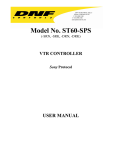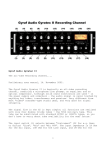Download Apple U96511-109B User's Manual
Transcript
Learning About OpenDoc Includes instructions to learn to use OpenDoc and the OpenDoc Essentials Kit K Apple Computer, Inc. © 1997 Apple Computer, Inc. All rights reserved. Under the copyright laws, this manual may not be copied, in whole or in part, without the written consent of Apple. Your rights to the software are governed by the accompanying software license agreement. The Apple logo is a trademark of Apple Computer, Inc., registered in the U.S. and other countries. Use of the “keyboard” Apple logo (Option-Shift-K) for commercial purposes without the prior written consent of Apple may constitute trademark infringement and unfair competition in violation of federal and state laws. Every effort has been made to ensure that the information in this manual is accurate. Apple is not responsible for printing or clerical errors. Apple Computer, Inc. 1 Infinite Loop Cupertino, CA 95014-2084 408-996-1010 http://www.apple.com Apple, the Apple logo, Mac, OpenDoc , and QuickTime are trademarks of Apple Computer, Inc., registered in the U.S. and other countries. Adobe, Acrobat, Adobe Illustrator, Adobe Photoshop, and PostScript are trademarks of Adobe Systems Incorporated or its subsidiaries and may be registered in certain jurisdictions. Helvetica and Times are registered trademarks of Linotype-Hell AG and/or its subsidiaries. PowerPC is a trademark of International Business Machines Corporation, used under license therefrom. Simultaneously published in the United States and Canada. Mention of third-party products is for informational purposes only and constitutes neither an endorsement nor a recommendation. Apple assumes no responsibility with regard to the performance or use of these products. Preface Read this manual when you are ready to learn to use OpenDoc. Make sure that OpenDoc and the OpenDoc Essentials are installed on your computer (see your installation manual or user’s guide for instructions). iii Getting Started With OpenDoc What is OpenDoc? OpenDoc is a new software technology for the Mac OS that lets you add software components called parts to your documents. When you drag a part into a document, also called a container part, the part’s functionality is added to the document. For example, the document below contains a variety of parts. This text is content in the container part. Graphics part Internet part You can add parts to documents created by OpenDoc-aware application programs, or you can create documents entirely out of parts. Parts are currently available from some software developers. A few sample parts have been included on your computer’s hard disk. 1 Why use OpenDoc? OpenDoc lets you focus on the things you want to create (documents) rather than the tools you use to create them (application programs). With OpenDoc, you can mix and match software components to create a work environment ideally suited to your needs. You can use your favorite text editor, your favorite drawing tools, and your favorite spreadsheet tools—all within the same document. Not only that, you can create documents that contain different types of data— text, numbers, graphics, video, sound—and edit each type of data within the document. You don’t need to switch back and forth between applications. Creating and editing a simple multimedia document To get familiar with OpenDoc, try the tips and exercises on these pages. Seeing what you have to work with m Look in the folder named “Stationery” on your computer’s hard disk. You can also choose OpenDoc Stationery from the Apple (K) menu to open the Stationery folder. The folder contains some parts you can use. These parts are installed with the OpenDoc Essentials Kit: 2 Creating a new document 1 Double-click the Apple Draw icon. A new document appears. Apple Draw is an example of a container part—a part that’s capable of accepting other parts. You can create a document by double-clicking the icon for any container part. Note that all parts have their own unique qualities, including different tool palettes and menus. The tool palette that appears when you open Apple Draw are for working in your Apple Draw document. 2 Draw a simple picture using Apple Draw’s drawing tools. You create and select shapes just as you would in an ordinary drawing program. Adding more graphics to your document 1 Drag the icon for a graphics file into your Apple Draw document. If you don’t have a graphics file handy, choose Scrapbook from the Apple (K) menu. Drag a picture from the Scrapbook into your document. A picture appears in the document. This picture is a part. When you drag a graphic into a container, the graphic is automatically displayed by the Apple Image Viewer. (You have similar viewers for displaying QuickTime 3-D images and QuickTime movies.) 2 Drag another graphic into your document. (You can drag an image from the Scrapbook.) 3 Working with an active part To work with the content of a part, you need to make the part active. 1 Click anywhere in your Apple Draw document, except in the graphics you dragged to your document. The Apple Draw container part is active, and the Apple Draw menus appear. The menu items change depending on which part is active. 2 Click anywhere in your graphic. Now the Apple Image Viewer becomes active, and its menus appear. Notice that a gray box appears around the graphic to indicate that it is active. The menus for the active part appear. The tool palette for the active part appears. In this case, the Image Viewer part is active. 3 When a part is active, a gray border appears around the part. Make sure your graphic is active. (There should be a gray box around it.) Then look at the menus to see which commands are available. In the Image menu, you should see commands for zooming and resizing your graphic. There is also a tool palette that lets you work with your image. 4 Working with a selected part To manipulate the part (to move, resize, or delete it), you first need to select the part. Selecting a part is different from making a part active. 1 To select a part, click the gray border of an active part. When you move the pointer onto the gray border, a hand appears. Click when you see the hand. Black “handles” appear at the corners of the graphic to indicate that the part is selected. Notice that the Image menu is no longer available. The menus for the container part appear. This tool palette is for the Apple Draw, the container part. When a part is selected, black handles appear. You can also select a part by holding down the Command (x) key on your keyboard while clicking anywhere in the part. 2 Move the selected part by dragging it. Make sure your graphic is selected. (There should be black handles at the corners.) Then look at the menus to see which commands are available. The container part’s menus are available when a part is selected. 3 Try the “Move to Back” and “Move to Front” commands in the Item menu. 4 Explore the Part Info command in the Edit menu. Part Info gives you information about each part. 5 “Active” vs. “Selected”: What’s the difference? Think of a cup of water. The things you can do with the water (such as stirring or sweetening it) are different from the things you can do with the cup (such as moving or lifting it). That’s basically the difference between working with an active part and working with a selected part. An active part is like the water; a selected part is like the glass. You make a part active m when you want to work with the contents of the part m by clicking anywhere in the part When a part is active, a gray border appears around it, and the menu items for the part appear in the menu bar. When a part is active, its menus are available in the menu bar. Only one part can be active at a time. You select a part m when you want to move, resize, or delete the part m by clicking the gray border of an active part, or by clicking the part while holding down the Command (x) key on the keyboard When a part is selected, “handles” appear at its corners. You can now resize, move, or delete the part. When a part is selected, the container part’s menus are available in the menu bar. You can select multiple parts. 6 Saving your work 1 Choose Save (followed by the name of your document) from the Document menu. Be careful to choose Save and not Save As. 2 Name your document. To change the name of a document, choose Document Info from the Document menu and type a new name in the Name box. To save a copy of the document, choose Save a Copy. When you choose Save a Copy, a copy is saved, but the original document remains open on the screen. You continue to work in your original document—not the copy that you saved. Creating a button 1 Drag the Apple Button icon from the Stationery folder into your document. A button appears in the document. You can put graphics, sounds, and scripts into an Apple Button part. 2 Drag the icon for a graphics file, or a graphic from the Scrapbook, onto the button. The picture you dragged appears on the button. 3 Drag the icon for a sound file or a sound from the Scrapbook onto the button. Now, when you click the button, the sound plays. If you want to record your own sound, drag the Apple Audio icon from the Stationery folder into your document (being careful not to put it on the button). Click the sound controls to make the Apple Audio art active. Then click Record (recording starts immediately). Click Stop when you are finished recording. After you’ve recorded your sound, select the sound controls and drag them onto the button. To save what you recorded as a sound file, drag the Apple Audio part to the desktop. To move a button, select the button by holding down the Command (x) key as you click it and move the button anywhere in your document. To change the label that is displayed on the button, select the button by holding down the Command (x) key as you click it. Then choose Part Info from the Edit menu, click Settings, and type a new label for the button. 7 Getting help while you work You can get help while working with OpenDoc parts by looking in the Guide (h) menu for step-by-step instructions. The onscreen help includes instructions for using all the parts in your document. 1 Choose the guide for your document from the Guide menu. The name of the guide is the name of your document followed by “Guide”. 2 Choose a topic area from the list on the left and explore the help that is available. There is general help for OpenDoc and for using specific parts. You can also use the Index and the Look For features to find help on specific topics. 8 Closing your document m When you are finished working close your document. You may be used to choosing Quit when you work in application programs. When you close an OpenDoc document, you automatically quit. If you get stuck Using OpenDoc is different from the way you’re used to working, so it might take some time to get used to it. If you ever get lost or confused, here are some tips for getting back on track: m Make sure the document you want to work in is active. You should see stripes across the title bar at the top of the window; if you don’t, click the window to make it active. m Make sure the part you want to work with is active. You can make a part active by clicking it. m If you try to work with a part and nothing seems to happen, you need to select the part first. (You select a part by clicking the gray border of an active part, or holding down the Command [x] key as you click the part.) 9 Apple Computer, Inc. 1 Infinite Loop Cupertino, California 95014-2084 408-996-1010 http://www.apple.com U96511-109B 034-0048-B Printed in U.S.A.





















